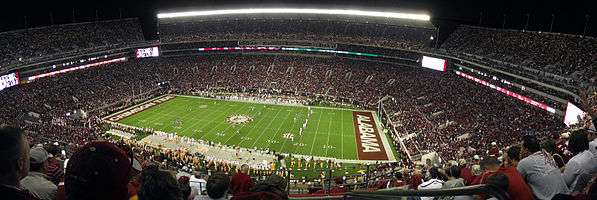Bryant–Denny Stadium
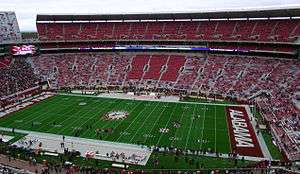 | |
| Former names | Denny Stadium (1929–1975) |
|---|---|
| Location |
920 Paul W Bryant Drive Tuscaloosa, Alabama 35401 USA |
| Coordinates | 33°12′28″N 87°33′2″W / 33.20778°N 87.55056°WCoordinates: 33°12′28″N 87°33′2″W / 33.20778°N 87.55056°W |
| Owner | University of Alabama |
| Operator | University of Alabama |
| Capacity |
18,000 (1929–1935) 24,000 (1936–1945) 31,000 (1946–1960) 43,000 (1961–1965) 60,210 (1966–1987) 70,123 (1988–1997) 83,818 (1998–2004) 81,018 (2005) 92,138 (2006–2008) 92,012 (2009) 101,821 (2010–present)[1] |
| Record attendance | 101,821 (numerous times) |
| Surface |
Grass (1929–1967, 1992–present) AstroTurf (1968–1991) |
| Construction | |
| Broke ground | December 1928 |
| Opened | September 28, 1929[2] |
| Expanded |
1937: East side bleachers 1950: 7,000+ seats 1961: 18,000+ seats 1966: 17,000+ seats 1988: West side upper deck 1998: East side upper deck 2006: North end zone and upper deck 2010: South end zone and upper deck |
| Construction cost |
$196,000[3] ($2.71 million in 2016 dollars[4]) |
| Tenants | |
|
Alabama Crimson Tide (NCAA) (1929–present) Alabama High School Athletic Association (2009–present) | |
Bryant–Denny Stadium, located in Tuscaloosa, Alabama, United States, is the home stadium for the University of Alabama Crimson Tide football team. The stadium opened in 1929 and was originally named Denny Stadium in honor of George H. Denny, the school's president from 1912 to 1932. In 1975, the Alabama legislature added longtime football coach Paul "Bear" Bryant's name to the stadium. Bryant would coach the remaining seven seasons of his career in the stadium, making him one of the few collegiate coaches to have coached in an arena or stadium that is (partially) named for him.
It has a seating capacity of 101,821, and is the fourth largest stadium in the Southeastern Conference, the seventh largest stadium in the United States and the eighth largest stadium in the world.
Construction
Serving as a replacement for Denny Field, Denny Stadium opened on September 28, 1929, with 6,000 in attendance for a 55–0 victory over Mississippi College.[5] It was officially dedicated the following week at Homecoming ceremonies against Ole Miss, a game the Crimson Tide would win 22–7.[6] Originally, the stadium had a capacity of 12,000—the lower half of the current stadium's east grandstand. However, President Denny initially envisioned a full bowl stadium capable of seating 66,000 people.[7] In 1937, the first expansion of the stadium added 6,000 seats along the east sideline to increase the capacity to 18,000.[7] Further expansions in 1950, 1961, and 1966 raised capacity to 25,000, 43,000, and 60,000, respectively. A 10,000-seat upper deck was added in 1987–88 for a capacity of 70,123. During the construction, the Crimson Tide was forced to play its entire 1987 home schedule at Birmingham's Legion Field, 56 miles (90 km) from the Tuscaloosa campus.[8]
East upper deck (1998)
In September 1995, the University of Alabama System Board of Trustees approved the construction of the east upper deck.[9] Designed by the architectural firm of Heery-Chambless-Adams, the construction was financed by the university and $4.65 million from the city of Tuscaloosa, the city of Northport and Tuscaloosa County.[9] The localities contributed to construction costs in return for the university pledging to move all Crimson Tide home games to Bryant–Denny and not play any at Legion Field.[9] The new upper deck provided 10,000 additional bleacher seats and 81 skyboxes on two levels—63 16-seat and 18 24-seat capacity boxes.[10] In 1999, four additional skyboxes were built to bring total number of skyboxes to 85. A JumboTron scoreboard with video display capabilities was erected in the south end zone and was at the time the largest in collegiate sports.[11] Additionally, a new east side entrance tower, a brick facade and reception areas for the Scholarship and A-Club level patrons was also added during the 1998 expansion. On September 5, 1998, the stadium's eastern upper deck was opened, and raised its official seating capacity to 83,818 at a final cost of $35 million.[12] In the first game in the newly expanded stadium, Alabama defeated BYU 38–31, with Shaun Alexander scoring an Alabama single-game record five touchdowns in the win.[13]
North end zone expansion (2006)
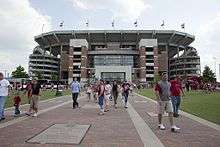
Following the 2004 football season, the university spent approximately $47 million on an expansion to the north end zone, which was completed days before the 2006 season opener against Hawaii. The expansion added a new upper deck to the North end zone area, complete with three different levels of skyboxes, which collectively are known as "The Zone", which brought the number of skyboxes in the stadium to 123. Two large display screens by Daktronics were placed in each corner of the north end zone. LCD ribbon screens, 3.5 feet (1.1 m) tall by 422 feet (129 m) wide, were placed along the front edge of the east and west upper decks.
Massive changes were made to the grounds of north side of the stadium with the addition of a Walk of Champions. Building the Walk of Champions required the demolition of the Delta Kappa Epsilon fraternity house and the grading of the hill it sat upon. The Walk of Champions comprises a brick plaza leading from University Boulevard to the north end zone entrances. The plaza features 16 granite monuments set into the walkway commemorating the Crimson Tide's SEC and national championship teams throughout the years. Along the west side of the plaza are five roughly 2,000-pound (910 kg), 9-foot (2.7 m) tall bronze statues, one for each Alabama football coach who has led the Crimson Tide to a national championship. Each statue has a semicircular wall behind it bearing the coach's name and the year(s) that he led the team to a national championship. The first four statues, unveiled during the opening in 2006, included Wallace Wade, Frank Thomas, Paul "Bear" Bryant, and Gene Stallings.[14] The fifth statue, that of Nick Saban, was unveiled prior to the A-Day game on April 16, 2011. It commemorates Saban guiding Alabama to its 13th National Championship with a 37–21 win over the Texas Longhorns.
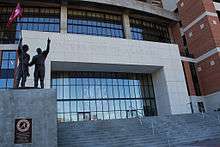
Finally, there is a bronze statuary group of two anonymous Alabama football players at the entrance to the north end zone, with the one on the left holding a large Alabama Crimson Tide flag upright on a flagpole. This player is wearing the number 18 and wearing a helmet, with the player on the right wearing the number 92 and pointing into the distance. The jersey numbers represent 1892, the year that the Crimson Tide began playing.[14]
The north end zone was opened for the 2006 season opener versus Hawaii, which set a new record attendance of 92,138. The Crimson Tide was victorious, 25–17.[15]
South end zone expansion (2010)
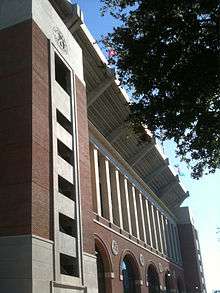
The University of Alabama Board of Trustees approved a study for further expansion of Bryant–Denny on September 19, 2008.[16] The Physical Properties Committee of the University of Alabama Board of Trustees heard a presentation from UA athletic department on November 13, 2008 regarding the proposed $80.6 million expansion of the south end zone upper deck and suite level of Bryant–Denny Stadium. The proposed expansion would bring the stadium's capacity to approximately 101,600, therefore making it the second largest stadium in the Southeastern Conference (SEC), and the fifth largest stadium in college football.[17] The committee unanimously approved the project to move into the third of four stages, the fourth being final approval to begin construction.[18]
On February 6, 2009, the university's Board of Trustees voted unanimously and without discussion to give the final approval for construction to commence on the south end zone expansion. With the approval of the Board of Trustees, construction began in the Spring 2009 and continued throughout the 2009 football season.[19][20] The expansion was finished in time for the first game of the team's 2010 season.
The Tuscaloosa News reported on April 17, 2009 that due to the economic climate and resultant lowered construction costs, the stadium expansion cost $15 million less than expected, coming in around $65.6 million.[21]

The expanded south end zone now includes a two level South Zone club with a total of 1,700 seats and 36 skyboxes to bring the total number of skyboxes in Bryant–Denny Stadium to 159, as well as an 8,500 seat upper deck. The entire stadium's audio/visual system was upgraded including two new video boards in both corners of the south end zone.[22]
Prior to the 2009 season, the large south scoreboard was disassembled to make way for the construction of the new stadium expansion. During this process, some welding equipment started a fire that burned the inside of the scoreboard.[23] Also, during this time, four new play clocks and down/distance indicators were installed (one behind each corner of the end zones) and a new LED game clock was placed behind the south goalpost.
The expansion was completed in mid-summer 2010 and held an official capacity of 101,821 making it the 5th largest college football stadium in the country. The new seats were all sold out quickly for the entire 2010 football season. In the future, the new expansion will include stores and other extras on the bottom of the end zone.
Football lore
Since its opening for the 1929 season through the 2010 season, the Crimson Tide owns a 212–50–3 all-time record at Bryant–Denny Stadium.[24] Bear Bryant is the leader in wins at Bryant–Denny, with an all-time record of 72–2 while head coach of Alabama.[24]
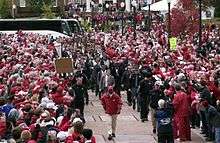
Despite its success at Bryant–Denny, most of Alabama's "home" football history from the 1920s through the 1980s occurred at Birmingham's Legion Field.[25] Well into the late 1990s, Legion Field hosted many of Alabama's important home games, including the Iron Bowl, which was considered a neutral site from 1948 through 1987. The Crimson Tide hosted Tennessee in odd-numbered years in Birmingham until 1999, and hosted LSU in even-numbered years from 1964 through 1986, except for 1980. Usually, Bryant–Denny hosted three or four games per season, mostly non-conference games, although the Tide always played Mississippi State in Tuscaloosa, save for 1987, due to the close distance between Tuscaloosa and Starkville. However, in 1998, when Bryant–Denny was expanded to a capacity exceeding Legion Field, the more important home games started to move to Bryant–Denny, culminating with the move of the Tennessee series to Tuscaloosa in 1999 and the Iron Bowl a year later.[26] From 1998 to 2003, Alabama continued to play two or three minor games in Birmingham. Finally, in 2003, Alabama played its final game at Legion Field against the South Florida Bulls, and now Bryant–Denny is the sole home of Alabama football.[25]
However, despite the majority of past big games being played at Legion Field, Bryant–Denny Stadium has hosted many memorable games, such as the 1994 shootout between Alabama's Jay Barker and Georgia's Eric Zeier, Marvin Constant's goal-line stop against LSU quarterback Josh Booty as time expired in 1999, Tyrone Prothro's reception over the back of Southern Miss defensive back Jasper Faulk in 2005, a 31–3 victory over No. 5 Florida in 2005, the Roman Harper-forced fumble against Tennessee in 2005 that helped the Crimson Tide to victory, Alabama's 36–0 shutout victory against Auburn in 2008 thus breaking the six-game losing streak and first ever Iron Bowl victory in Bryant–Denny Stadium, and Terrence Cody's field goal block against Tennessee as time expired in 2009. In recent years, Bryant–Denny Stadium had become a feared place to play again. Also Bryant-Denny has been put on many lists ranking it one of the best places to watch football. NCAA Football 11 ranked Alabama's Bryant–Denny as the fourth toughest place to play in the nation and third in the SEC behind Florida and LSU. Sporting News ranks it first while Bleacher Report has it ranked as the 5th toughest and the 2nd best stadium in the country.[27]
Field design
Until the turn of the millennium, the field at Bryant–Denny Stadium only had the necessary markings required for play. However, as more and more stadiums began to add other designs to the field, such as logos, Bryant–Denny Stadium chose to remain traditional, having very few field markings. In fact, even on into the 2002 season, Bryant–Denny had no logo at midfield (except during the 1992 centennial season) and no logos at the twenty-five yard lines, which are commonplace in many stadiums. The end zones were simply designed as such that the name "ALABAMA" was spelled out in a white, block style font. During the 2002 season, however, a rather large white script A was added to midfield.
The field design underwent full scale changes beginning with the 2004 season. At midfield, the large white script A was replaced with the script A logo, which is encircled by a crimson ring which has "Alabama Crimson Tide" written around it. The end zone designs, too, were changed to a crimson, block style font (though different than the block style font used in the earlier design) that was outlined in white.
For the 2006 season, two identical logos commemorating the 175th anniversary of the founding of the University of Alabama were also added to the field on the 25 yard lines. One was added on the south end of the stadium, on the west side of the playing field, while the other was on the north end of the stadium, on the east side of the playing field.
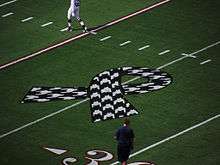
For the 2007 season, two identical logos commemorating the 75th anniversary of the founding of the Southeastern Conference were added to home field of every Southeastern Conference team. These were in the same places as the 175th logos were during the 2006 season.
For the 2008 season, two identical Southeastern Conference logos were added to the home field of every Southeastern Conference team. These are in the same places as the previous logos.
For the 2009 A-day game, the end zones were changed back to the original white block style font that was used prior to the 2004 season, except that the background was shaded crimson. The north end zone displays "ALABAMA", while the south end zone displays "CRIMSON TIDE". This design layout has remained in use since the 2009 season.[28]
For the 2011 season, two identical houndstooth awareness ribbons recognizing the ongoing relief efforts from the April 27, 2011 tornado were added to the field on the 25 yard lines.[29][30]
Locker rooms
In 2008, the visitors' locker room was officially named "The Fail Room" after alumnus and donor James M. Fail. Fail commented, "Earlier this year, when I saw the visitors' locker room as a potential naming right, I figured it was the most appropriate opportunity I would ever have to use my name."[31]
High school championships
Beginning in 2009, Bryant–Denny Stadium and Auburn University's Jordan–Hare Stadium became the homes of the Alabama High School Athletic Association state football championship games, known as the Super Six. Bryant-Denny hosts the Super Six in odd-numbered years, with Jordan–Hare taking the games in even-numbered years. Previously, the Super Six was held at Legion Field in Birmingham.
References
- ↑ "Facilities: Bryant–Denny Stadium". University of Alabama Athletic Department. Retrieved February 3, 2011.
- ↑ http://www.worldofstadiums.com/north-america/united-states/alabama/bryant-denny-stadium/
- ↑ http://www.seathound.com/venue/bryant-denny-stadium-8150/question/13429/how-much-did-bryant-denny-stadium-initially-cost-to-build-in-1929/
- ↑ Federal Reserve Bank of Minneapolis Community Development Project. "Consumer Price Index (estimate) 1800–". Federal Reserve Bank of Minneapolis. Retrieved October 21, 2016.
- ↑ Tubb, Donald (September 29, 1929). "Alabama gets 6 touchdowns by swift play in first half". The Tuscaloosa News. Retrieved February 1, 2011.
- ↑ Tubb, Donald (October 6, 1929). "12,000 see Alabama win, 22–7". The Tuscaloosa News. Retrieved February 1, 2011.
- 1 2 "Denny Stadium". The Tuscaloosa News. Google News Archives. October 8, 1937. p. 4. Retrieved April 12, 2012.
- ↑ Carroll, Andrew (January 25, 1987). "Renovation at Bryant–Denny welcome news". The Tuscaloosa News. Google News. p. 2F. Retrieved February 21, 2012.
- 1 2 3 Powell, Richard (September 16, 1995). "Stadium deal gets approval". The Tuscaloosa News. p. 1A. Retrieved February 5, 2011.
- ↑ Hurt, Cecil (October 10, 1998). "Skyboxes a popular addition to stadium". The Tuscaloosa News. p. 8C. Retrieved February 5, 2011.
- ↑ Deas, Tommy (October 10, 1998). "Jumbo view: Bama's big-screen scoreboard is the largest in college football". The Tuscaloosa News. p. C1.
- ↑ DeWitt, Robert (September 5, 1998). "So what else is new?". The Tuscaloosa News. p. 1. Retrieved February 5, 2011.
- ↑ Hurt, Cecil (September 6, 1998). "Alexander spearheads Tide shootout". The Tuscaloosa News. p. C1.
- 1 2 "Bryant–Denny Undergoing Monumental Change". Gadsden Times. June 29, 2006. Retrieved December 25, 2012.
- ↑ "Late defensive stand helps Tide hold off game Hawaii". ESPN. Associated Press. September 2, 2006. Retrieved October 7, 2008.
- ↑ "UA Trustees approve initial study for Bryant-Denny stadium expansion", Tuscaloosanews.com, September 19, 2008.
- ↑ Gallo, DJ (July 15, 2010). "Offeseason Pigskinpalooza: College Football's megastadiums". ESPN. Retrieved November 18, 2010.
- ↑ Bralley, Brett (November 14, 2008). "$80.6M budget approved for stadium expansion". The Crimson White. Retrieved November 18, 2008.
- ↑ Rapport, Ian (February 6, 2009). "It's official". The Birmingham News. Retrieved February 6, 2009.
- ↑ "Board of Trustees Officially Approves Bryant–Denny Stadium South End Zone Expansion Project". University of Alabama Athletic Department. February 6, 2009. Retrieved February 7, 2009.
- ↑ "UA Stadium Expansion Cheaper Than Expected". The Tuscaloosa News. April 17, 2009. Retrieved April 19, 2009.
- ↑ "Mal Moore Announces Request For Approval Of South End Zone Project". University of Alabama Athletic Department. February 6, 2009. Retrieved February 7, 2009.
- ↑ "Small fire strikes Bryant–Denny Stadium". Mobile Press-Register. February 19, 2009. Retrieved November 22, 2009.
- 1 2 "Bryant–Denny Stadium Year-By-Year Record" (PDF). 2010 Alabama Football Media Guide. University of Alabama Athletic Department. p. 138. Retrieved February 3, 2011.
- 1 2 "Alabama Football At Legion Field" (PDF). 2010 Alabama Football Media Guide. University of Alabama Athletic Department. pp. 141–142. Retrieved February 3, 2011.
- ↑ Hurt, Cecil (March 6, 1999). "Vols due in fall, AU in 2000". The Tuscaloosa News. p. 1. Retrieved February 3, 2011.
- ↑
- ↑ Photo of Bryant-Denny Stadium design for the 2009 A-day game
- ↑ Staff report (September 1, 2011). "Bryant–Denny unveils tornado ribbons". Rivals.com from Yahoo! Sports. Retrieved September 4, 2011.
- ↑ Gould, Izzy (September 2, 2011). "Alabama's opener against Kent State could help healing in Tuscaloosa". AL.com. Retrieved March 25, 2012.
- ↑ "Bryant–Denny Stadium Visitors Locker Room Named for James M. Fail" (Press release). University of Alabama Athletic Department. December 15, 2008. Retrieved December 15, 2008.
External links
| Preceded by Denny Field |
Home of the Alabama Crimson Tide 1929–present |
Succeeded by Current |
